Staircases serve as the only option of lifting to the upper tiers and floors in private households, cottages, cottages and other facilities combining several levels. In construction projects, ladder structures are laid out of various materials. Installation of stairs from concrete is a relevant solution for brick and block buildings.

Concrete stairs fit harmoniously into rooms with floors, filled with cement tile, decorated tiled coating. In terms of reliability and durability, concrete inter-storey transitions are not inferior to metal and wooden structures, but the process of building the march takes more time.
Advantages and disadvantages
The complexity and scale of work on the manufacture of a monolithic staircase does not diminish the advantages of the finished concrete structure from the positions of reliability and safe operation. Concrete construction can be issued under any interior style, turning ordinary steps into a masterpiece of decorative art. The main plus of this design is the possibility of internal and street editing.
The advantages of the concrete staircase on the second floor include:
- High strength and reliability. Such a design is well withstanding significant loads.
- Durability. Due to the high quality of the natural material, monolithic inter-storey transitions serve for decades.
- Resistance to moisture, fire. Concrete spans are not subject to the destructive power of the open flame, moisture-resistant.
- Do not need special care. The owners of a private house are quite periodically updated finishing design.
- Lack of creaks. Compared to wooden structures, concrete structures are resistant to temperature differences, moisture.
- Good combination with different materials. Concrete base greatly looks with marble, wrought, glass, ceramic, wooden finish.
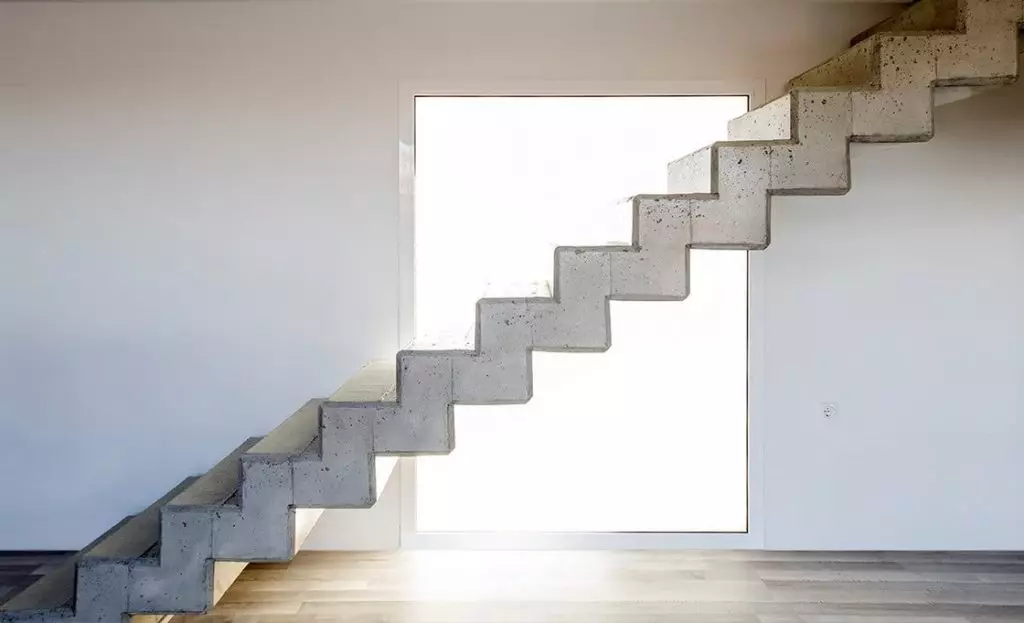
Reinforced concrete structures are made of durable bent reinforcement bonding cement mortar. Steps withstand perennial use cycles, and for a comfortable lift and descent, a concrete staircase in a private house is equipped with beautiful handrails.
The coldness and rectinity of lines and forms smooth with spectacular finish. Most often it is a natural tree.
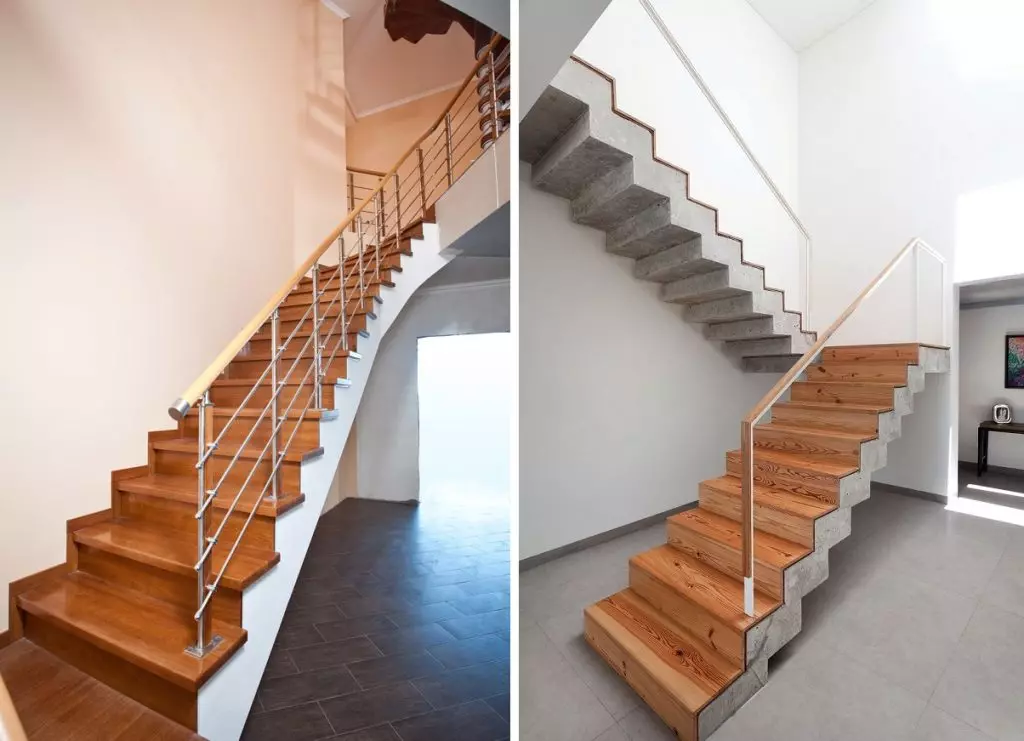
Despite a number of important advantages, concrete marches have some drawbacks:
- The laborious process of manufacturing and editing. The fill technology of concrete requires the observance of the pause for a reliable setting of the material, so in a couple of days it will not work the staircase.
- Massive appearance. If the design is not finished with decorative elements, concrete monolithium slightly disrupts the aesthetics of the interior. Interesting design solutions will be required for the finishing structures.
- High cost of materials. But this deficiency fully compensates for the durability of the concrete structure, its safety and ease of operation.
Article on the topic: Types and advantages of wooden stairs [Stage Performance Options]
The monolithic structure is possible to give different forms. For real estate owners, aesthetics is relevant to the placement of the stairs in the residential area or at the entrance to the house. Products are well cleaned, withstand significant dynamic loads, stair marches can be performed in any configuration, including spiral forms.
Concrete facilities are often used for mounting on the street. In this case, the stairs are owned by the porch running from the ground floor connecting the entrance and the terrace, attic, balcony.
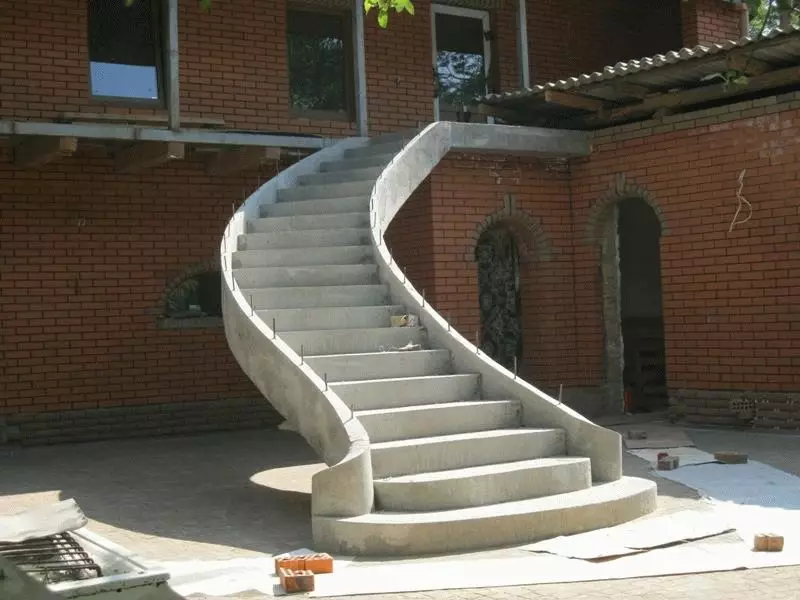
Popular versions
Stairs from reinforced concrete are developing at the design stage to harmoniously enter a heavy design in the interior of the house, cottage. The facilities are straight with concrete marching spans, screw with spiral-shaped swings. The type of support varies - on the walls from one or two sides, in the floor and the upper overlap.
The carrying capacity of the product does not depend on the method of installation - "hanging" designs are the same durable as structures adjacent to the walls.
![Advantages and design features of concrete stairs [Popular versions]](/userfiles/69/5095_5.webp)
Consider what concrete ladders are on the second floor:
- Direct single-hour construction. It is used for mounting in low rooms with two levels, simply connects the lower and upper tiers.
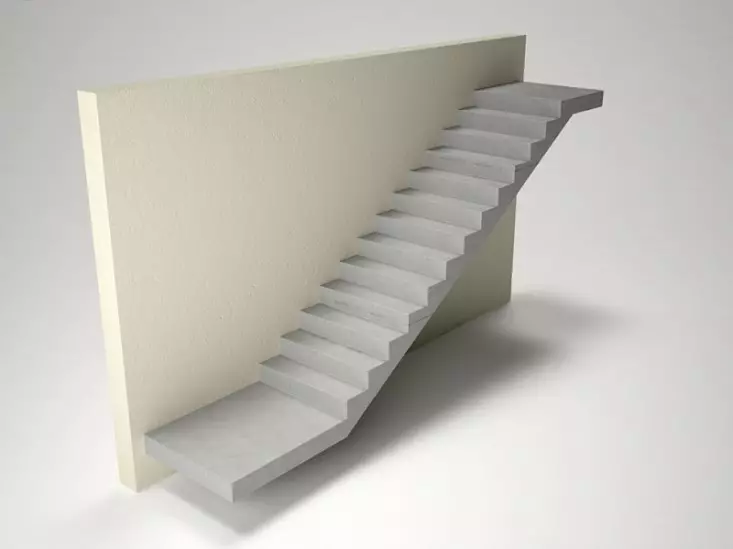
- Complex stairs M-shaped form. Successfully look in spacious rooms, may contain rotary steps, platforms.
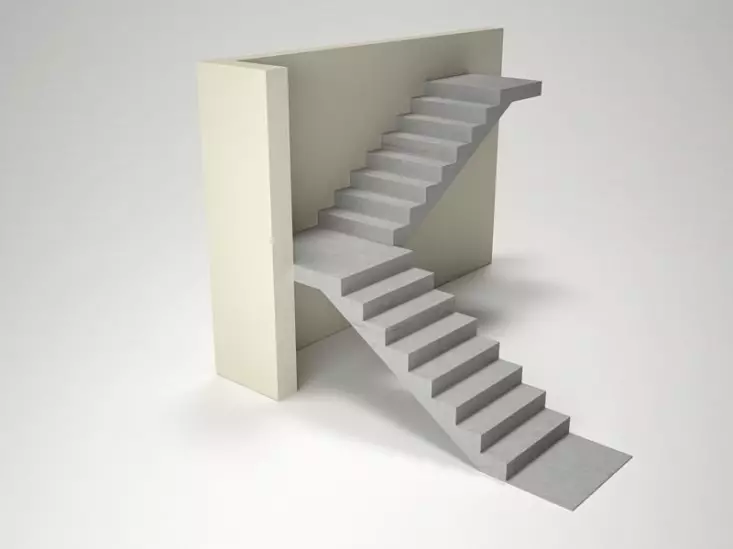
- P-shaped structures for high-storey houses. Marsh spans are connected by platforms, located at an angle of 180 °. Additional plus - saving places.
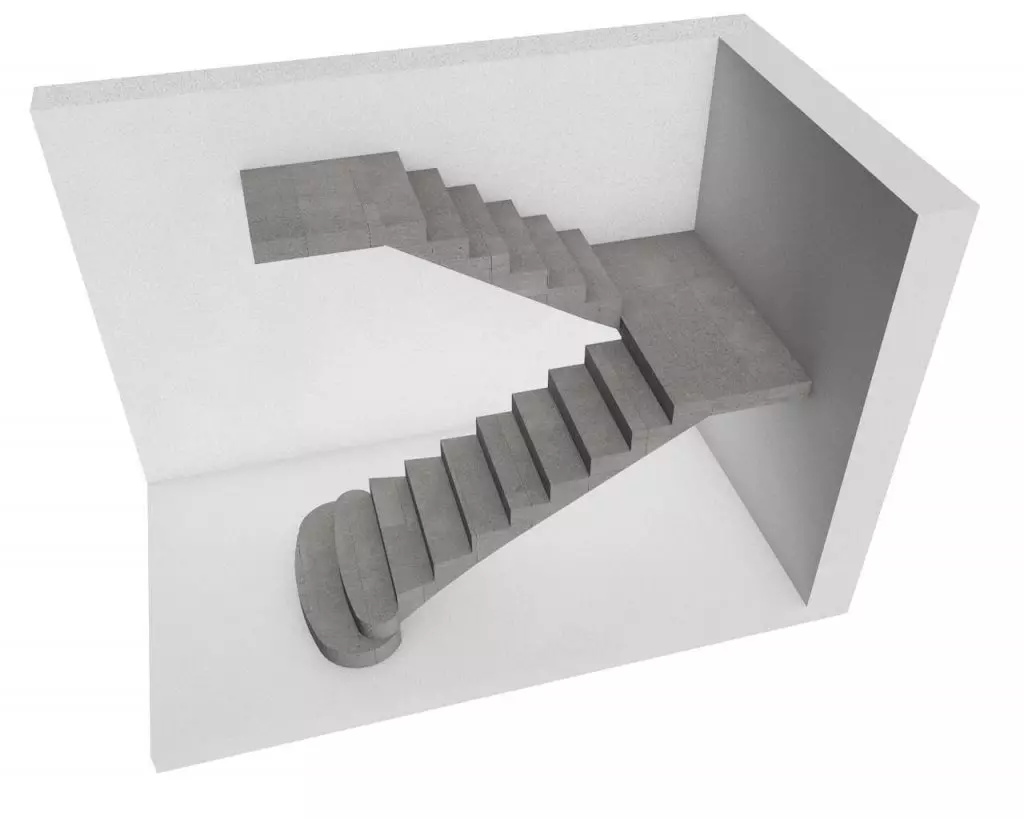
- Screw facilities made of concrete. Used under conditions of limited free space, curved lines are characteristic, creating steps of an unusual form.
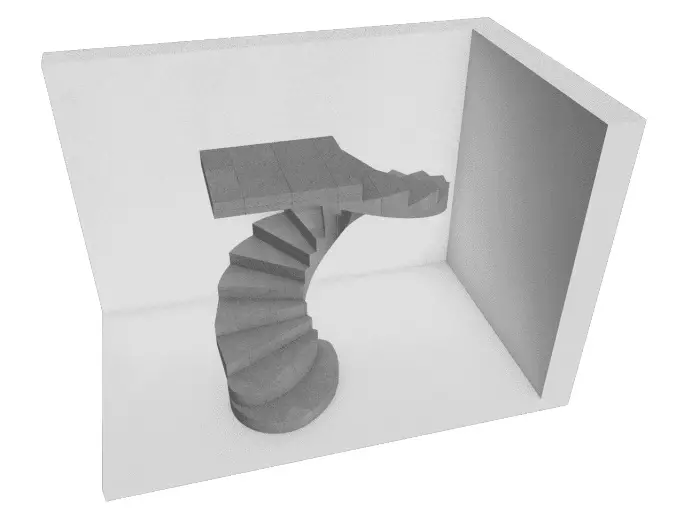
Inter-storey transitions are smoothly suitable in the form of the lower edge of the steps, with a double frame (step bottom) and options on the growths and cosos, levishing the heavyness of concrete. The weight of the structures is from one and a half to 2.5 tons, taking into account the reinforcement by iron rods, with which the full safety safety is ensured.
Screw
Screw stairs are beautiful facilities, converting interior and interior decoration at home. They can be built with their own hands, but the work is time consuming, requires a lot of time and defined skills. According to individual projects, experts will make a screw concrete design of any configuration, knowing the size of the room.
The construction process is based on the construction of the formwork and fill liquid concrete capable of receiving a different form.
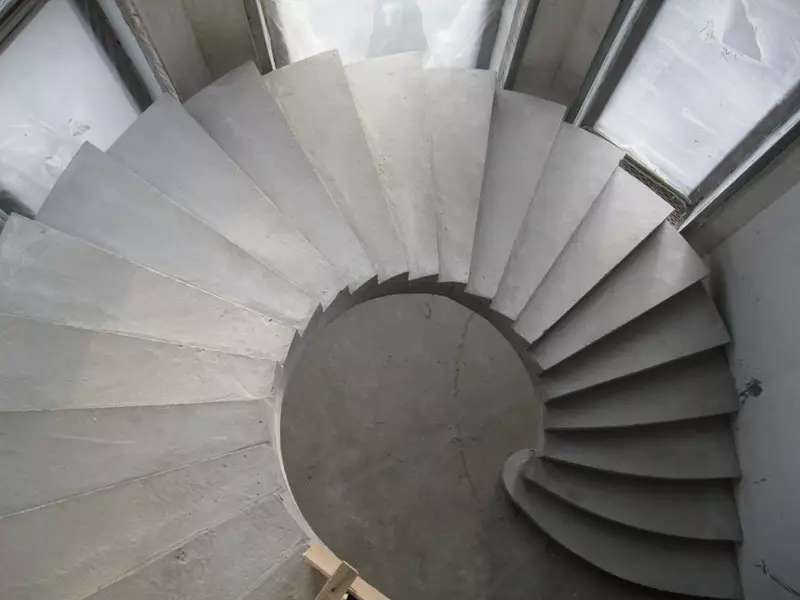
The screw concrete model has undoubted advantages:
- The weightlessness of the design - the staircase seems to soar in the air;
- Compact dimensions - the construction takes place at least a place;
- Steps are poured around the column, which serves as a support;
- serves as a binding-reinforcing frame between levels;
- May have a different angle of rotation, steady steps.
Article on the topic: How to choose a ladder-ladder: a variety of options and advice of professionals
In the finishing of screw stairs there is no style restrictions. For decorative design of the structure, tiles are used, metal inserts, wooden boards, crumb, laminate, porcelain stoneware, soft carpet. Facing materials must be laid on a flat surface.
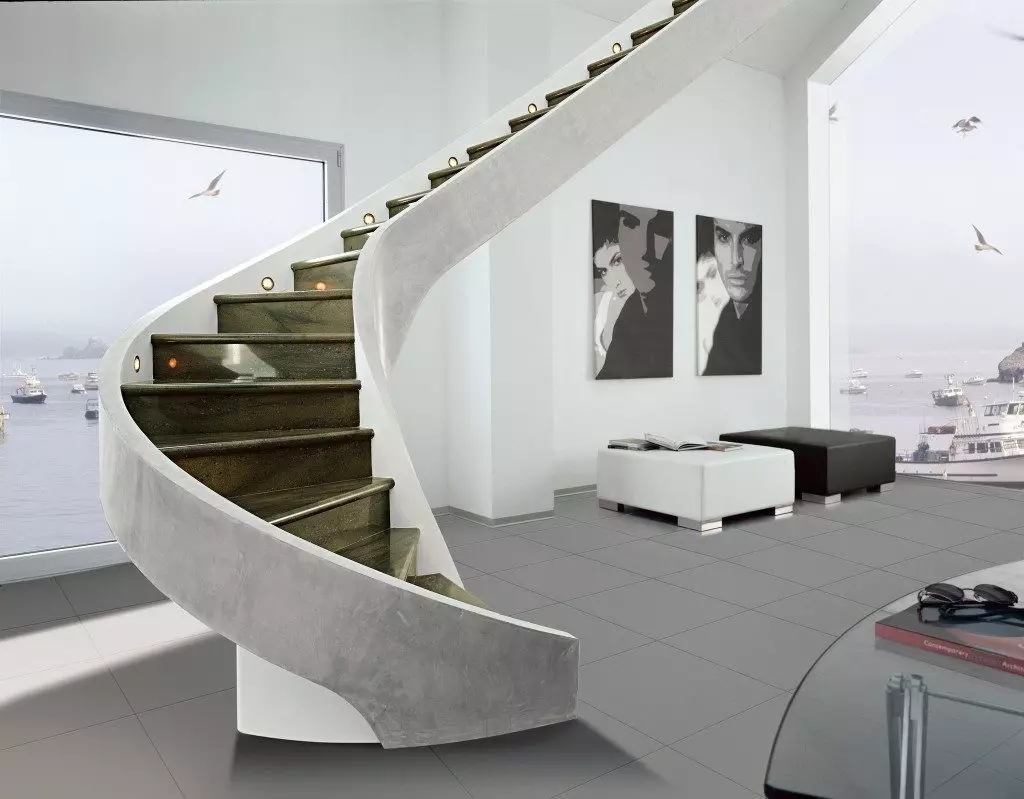
The spectacular decoration of the spiral staircase serve as a railing presented in an extensive assortment, which are mounted after mounting the structure.
![Advantages and design features of concrete stairs [Popular versions]](/userfiles/69/5095_12.webp)
Movie
When the area of the room allows you to mount a more overall concrete structure, household owners prefer marching models. They are considered safe for movement, and the size between the railing / handrails leaves enough space for lifting to the upper tier of furniture, technicians and other bulky items.
Features and advantages of concrete products:
- comfort of operation, manifold installation methods;
- Complete set of marching spans by intermediate sites;
- optimal width, height, length of steps, small steepness;
- Several types of structures are direct, P-shaped, M-shaped;
- The ability to "connect" several floors by the march staircase.
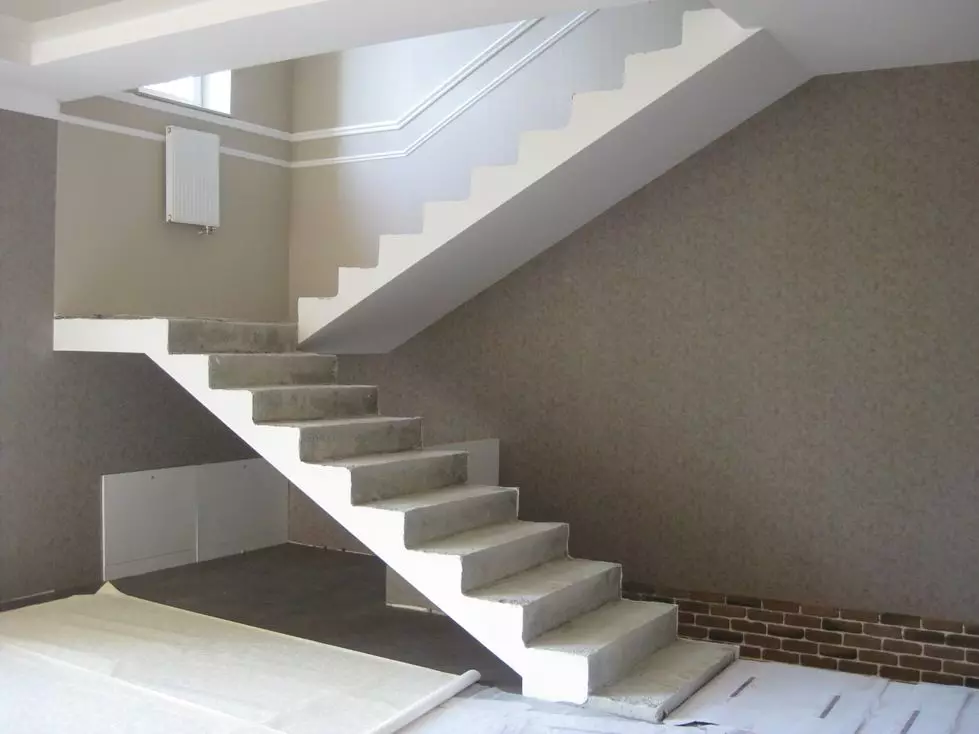
Produced made from concrete, complete swing steps for comfortable lifting, depending on the features of the mounting site. According to established standards for safe operation, it is necessary that the height of one march does not exceed 3 meters. Otherwise, it is worth equipping platforms between marchs.
![Advantages and design features of concrete stairs [Popular versions]](/userfiles/69/5095_14.webp)
For facing structures, the wood is best suited, granite, art forging. The space under the staircase can be used to organize storage areas.
![Advantages and design features of concrete stairs [Popular versions]](/userfiles/69/5095_15.webp)
Steps
In a simple understanding, the staircase is a device with steps connecting floors, levels, tiers. Concrete stairs for stairs are attached to the supports that the side walls, the testers, the boosters can serve. The lower part of the staircase can be restarted in the floor, the top - in the opening of the next floor.
![Advantages and design features of concrete stairs [Popular versions]](/userfiles/69/5095_16.webp)
Comfortable operation of the staircase depends on the shape, thickness and size of steps. When developing design projects, designers use original solutions - mortise steps, "goose step" steps, asymmetrical fragments.
There are certain requirements for the size and angle of rotation of the steps to consider:
- The optimal length is at least 80-90 cm;
- Standard in height of concrete sticking - 17-18 cm;
- width for a comfortable step (feet) - 25-30 cm;
- the number of steps in the march - no more than 18;
- The optimal angle of inclination of the stairs is 30-45º;
- Svet must be 20-30 mm.
Article on the topic: A stool with a transformation into a ladder - a universal chair or two subjects in one
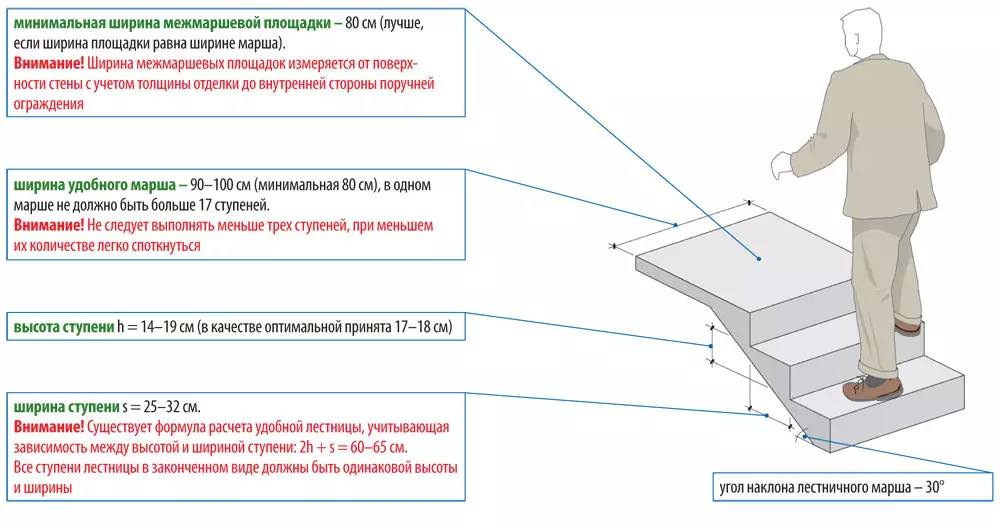
Stairs can have a different configuration, height, installation type. Products made of durable concrete require the fulfillment of detailed calculations at the design stage of the house. The solution must be given time for drying, so the construction of stairs is performed in several stages.
In the video: the main types of monolithic stairs and the calculation of a simple march.
Finishing options
Concrete monolithic stairs can be fermented with various materials. The most popular options are considered:
- Wood - a traditional solution, the material visually unloads heavy concrete, gives interior with warm notes. For finishing, it is rational to use strong wood species that resist abrasions (beech, ash, oak).
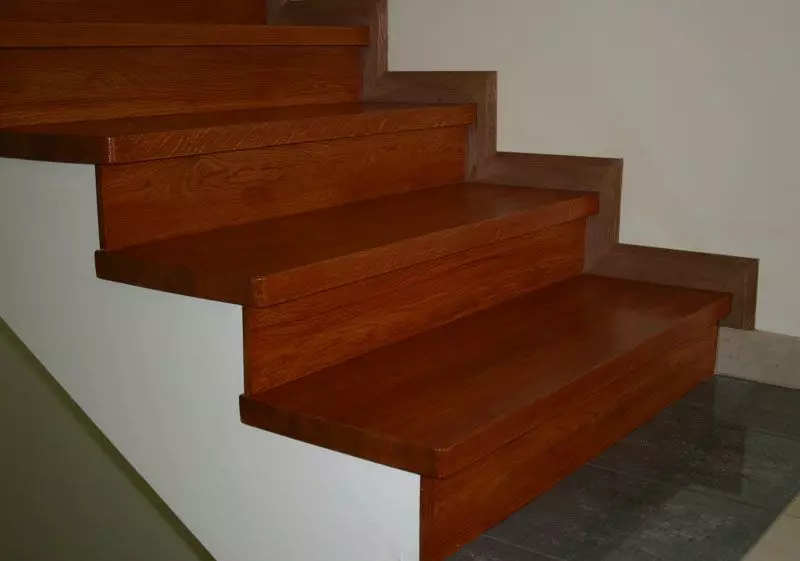
- Stone is the current option for finding a staircase located indoors in the classic style. Marble steps will decorate a concrete product, but we must not forget that they are taking the overall weight of the design. Stone facing refers to the category of elite finishes, it is expensive, but it looks solid and harmoniously.
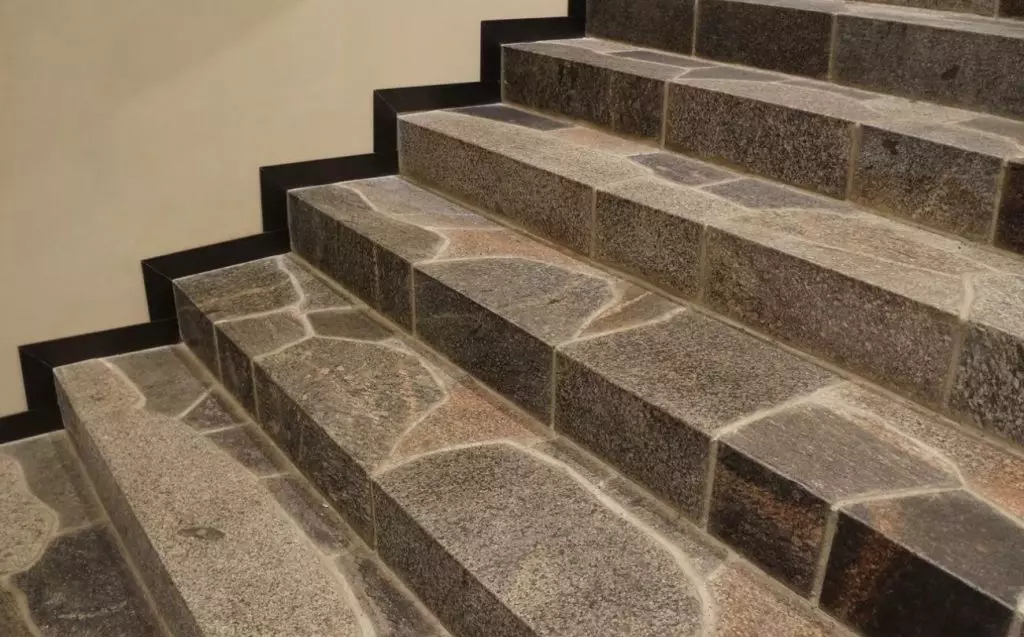
- Porcelain stoneware - durable finish, preserving the original appearance over the years. Steps from porcelain stoneware and clinker ceramics should be equipped with anti-slip coating. Facing takes a lot of time, for the installation of porcelain, you need a special technique, it is desirable to have the skills of working with the material.
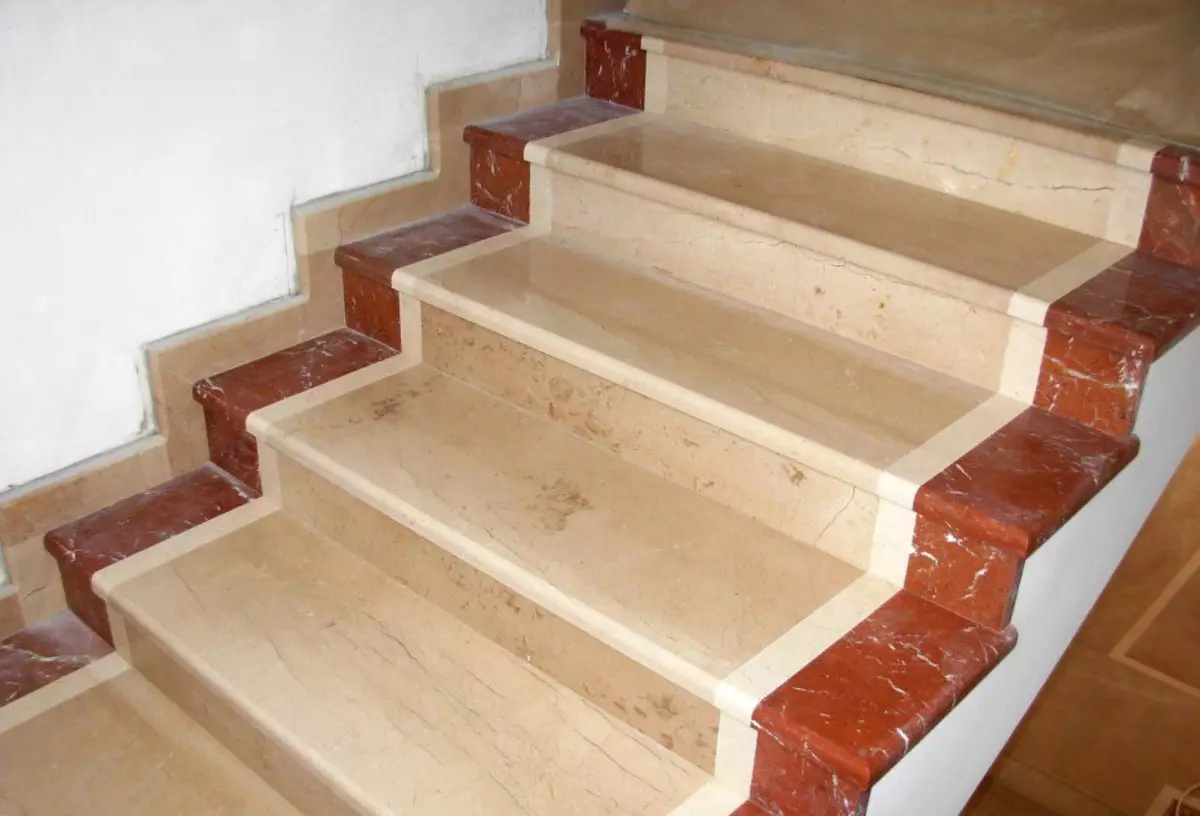
- Soft coatings - carpet, linoleum, laminate fit perfectly into the overall design of concrete facilities. When choosing carpet, the material on a rubber basis is preferred. Linoleum and laminate are fixed on sticking with glue. It is necessary to choose non-smooth materials to avoid the slip effect on steps.
![Advantages and design features of concrete stairs [Popular versions]](/userfiles/69/5095_21.webp)
Beautifully look at concrete combinations with glass or metal. Manufacturers of railings and stair fences offer a varied selection of products at an acceptable cost. Glass fragments are more fragile, but give concrete monolith lightness, transparency. Metal wrought railing with intricate art elements effectively emphasize the shapes and lines of the staircase, decorate the cold concrete.
Facing concrete steps with wood (1 video)
Monolithic stairs with finishing and without (64 photos)
![Advantages and design features of concrete stairs [Popular versions] Advantages and design features of concrete stairs [Popular versions]](/userfiles/69/5095_22.webp)
![Advantages and design features of concrete stairs [Popular versions] Advantages and design features of concrete stairs [Popular versions]](/userfiles/69/5095_23.webp)
![Advantages and design features of concrete stairs [Popular versions] Advantages and design features of concrete stairs [Popular versions]](/userfiles/69/5095_24.webp)
![Advantages and design features of concrete stairs [Popular versions] Advantages and design features of concrete stairs [Popular versions]](/userfiles/69/5095_25.webp)
![Advantages and design features of concrete stairs [Popular versions] Advantages and design features of concrete stairs [Popular versions]](/userfiles/69/5095_26.webp)
![Advantages and design features of concrete stairs [Popular versions] Advantages and design features of concrete stairs [Popular versions]](/userfiles/69/5095_27.webp)
![Advantages and design features of concrete stairs [Popular versions] Advantages and design features of concrete stairs [Popular versions]](/userfiles/69/5095_28.webp)
![Advantages and design features of concrete stairs [Popular versions] Advantages and design features of concrete stairs [Popular versions]](/userfiles/69/5095_29.webp)
![Advantages and design features of concrete stairs [Popular versions] Advantages and design features of concrete stairs [Popular versions]](/userfiles/69/5095_30.webp)
![Advantages and design features of concrete stairs [Popular versions] Advantages and design features of concrete stairs [Popular versions]](/userfiles/69/5095_31.webp)
![Advantages and design features of concrete stairs [Popular versions] Advantages and design features of concrete stairs [Popular versions]](/userfiles/69/5095_32.webp)
![Advantages and design features of concrete stairs [Popular versions] Advantages and design features of concrete stairs [Popular versions]](/userfiles/69/5095_33.webp)
![Advantages and design features of concrete stairs [Popular versions] Advantages and design features of concrete stairs [Popular versions]](/userfiles/69/5095_34.webp)
![Advantages and design features of concrete stairs [Popular versions] Advantages and design features of concrete stairs [Popular versions]](/userfiles/69/5095_35.webp)
![Advantages and design features of concrete stairs [Popular versions] Advantages and design features of concrete stairs [Popular versions]](/userfiles/69/5095_36.webp)
![Advantages and design features of concrete stairs [Popular versions] Advantages and design features of concrete stairs [Popular versions]](/userfiles/69/5095_37.webp)
![Advantages and design features of concrete stairs [Popular versions] Advantages and design features of concrete stairs [Popular versions]](/userfiles/69/5095_38.webp)
![Advantages and design features of concrete stairs [Popular versions] Advantages and design features of concrete stairs [Popular versions]](/userfiles/69/5095_39.webp)
![Advantages and design features of concrete stairs [Popular versions] Advantages and design features of concrete stairs [Popular versions]](/userfiles/69/5095_40.webp)
![Advantages and design features of concrete stairs [Popular versions] Advantages and design features of concrete stairs [Popular versions]](/userfiles/69/5095_41.webp)
![Advantages and design features of concrete stairs [Popular versions] Advantages and design features of concrete stairs [Popular versions]](/userfiles/69/5095_42.webp)
![Advantages and design features of concrete stairs [Popular versions] Advantages and design features of concrete stairs [Popular versions]](/userfiles/69/5095_43.webp)
![Advantages and design features of concrete stairs [Popular versions] Advantages and design features of concrete stairs [Popular versions]](/userfiles/69/5095_44.webp)
![Advantages and design features of concrete stairs [Popular versions] Advantages and design features of concrete stairs [Popular versions]](/userfiles/69/5095_45.webp)
![Advantages and design features of concrete stairs [Popular versions] Advantages and design features of concrete stairs [Popular versions]](/userfiles/69/5095_46.webp)
![Advantages and design features of concrete stairs [Popular versions] Advantages and design features of concrete stairs [Popular versions]](/userfiles/69/5095_47.webp)
![Advantages and design features of concrete stairs [Popular versions] Advantages and design features of concrete stairs [Popular versions]](/userfiles/69/5095_48.webp)
![Advantages and design features of concrete stairs [Popular versions] Advantages and design features of concrete stairs [Popular versions]](/userfiles/69/5095_49.webp)
![Advantages and design features of concrete stairs [Popular versions] Advantages and design features of concrete stairs [Popular versions]](/userfiles/69/5095_50.webp)
![Advantages and design features of concrete stairs [Popular versions] Advantages and design features of concrete stairs [Popular versions]](/userfiles/69/5095_51.webp)
![Advantages and design features of concrete stairs [Popular versions] Advantages and design features of concrete stairs [Popular versions]](/userfiles/69/5095_52.webp)
![Advantages and design features of concrete stairs [Popular versions] Advantages and design features of concrete stairs [Popular versions]](/userfiles/69/5095_53.webp)
![Advantages and design features of concrete stairs [Popular versions] Advantages and design features of concrete stairs [Popular versions]](/userfiles/69/5095_54.webp)
![Advantages and design features of concrete stairs [Popular versions] Advantages and design features of concrete stairs [Popular versions]](/userfiles/69/5095_55.webp)
![Advantages and design features of concrete stairs [Popular versions] Advantages and design features of concrete stairs [Popular versions]](/userfiles/69/5095_56.webp)
![Advantages and design features of concrete stairs [Popular versions] Advantages and design features of concrete stairs [Popular versions]](/userfiles/69/5095_57.webp)
![Advantages and design features of concrete stairs [Popular versions] Advantages and design features of concrete stairs [Popular versions]](/userfiles/69/5095_58.webp)
![Advantages and design features of concrete stairs [Popular versions] Advantages and design features of concrete stairs [Popular versions]](/userfiles/69/5095_59.webp)
![Advantages and design features of concrete stairs [Popular versions] Advantages and design features of concrete stairs [Popular versions]](/userfiles/69/5095_60.webp)
![Advantages and design features of concrete stairs [Popular versions] Advantages and design features of concrete stairs [Popular versions]](/userfiles/69/5095_61.webp)
![Advantages and design features of concrete stairs [Popular versions] Advantages and design features of concrete stairs [Popular versions]](/userfiles/69/5095_62.webp)
![Advantages and design features of concrete stairs [Popular versions] Advantages and design features of concrete stairs [Popular versions]](/userfiles/69/5095_63.webp)
![Advantages and design features of concrete stairs [Popular versions] Advantages and design features of concrete stairs [Popular versions]](/userfiles/69/5095_64.webp)
![Advantages and design features of concrete stairs [Popular versions] Advantages and design features of concrete stairs [Popular versions]](/userfiles/69/5095_65.webp)
![Advantages and design features of concrete stairs [Popular versions] Advantages and design features of concrete stairs [Popular versions]](/userfiles/69/5095_66.webp)
![Advantages and design features of concrete stairs [Popular versions] Advantages and design features of concrete stairs [Popular versions]](/userfiles/69/5095_68.webp)
![Advantages and design features of concrete stairs [Popular versions] Advantages and design features of concrete stairs [Popular versions]](/userfiles/69/5095_69.webp)
![Advantages and design features of concrete stairs [Popular versions] Advantages and design features of concrete stairs [Popular versions]](/userfiles/69/5095_70.webp)
![Advantages and design features of concrete stairs [Popular versions] Advantages and design features of concrete stairs [Popular versions]](/userfiles/69/5095_71.webp)
![Advantages and design features of concrete stairs [Popular versions] Advantages and design features of concrete stairs [Popular versions]](/userfiles/69/5095_72.webp)
![Advantages and design features of concrete stairs [Popular versions] Advantages and design features of concrete stairs [Popular versions]](/userfiles/69/5095_73.webp)
![Advantages and design features of concrete stairs [Popular versions] Advantages and design features of concrete stairs [Popular versions]](/userfiles/69/5095_74.webp)
![Advantages and design features of concrete stairs [Popular versions] Advantages and design features of concrete stairs [Popular versions]](/userfiles/69/5095_75.webp)
![Advantages and design features of concrete stairs [Popular versions] Advantages and design features of concrete stairs [Popular versions]](/userfiles/69/5095_76.webp)
![Advantages and design features of concrete stairs [Popular versions] Advantages and design features of concrete stairs [Popular versions]](/userfiles/69/5095_77.webp)
![Advantages and design features of concrete stairs [Popular versions] Advantages and design features of concrete stairs [Popular versions]](/userfiles/69/5095_78.webp)
![Advantages and design features of concrete stairs [Popular versions] Advantages and design features of concrete stairs [Popular versions]](/userfiles/69/5095_79.webp)
![Advantages and design features of concrete stairs [Popular versions] Advantages and design features of concrete stairs [Popular versions]](/userfiles/69/5095_80.webp)
![Advantages and design features of concrete stairs [Popular versions] Advantages and design features of concrete stairs [Popular versions]](/userfiles/69/5095_81.webp)
![Advantages and design features of concrete stairs [Popular versions] Advantages and design features of concrete stairs [Popular versions]](/userfiles/69/5095_82.webp)
![Advantages and design features of concrete stairs [Popular versions] Advantages and design features of concrete stairs [Popular versions]](/userfiles/69/5095_83.webp)
![Advantages and design features of concrete stairs [Popular versions] Advantages and design features of concrete stairs [Popular versions]](/userfiles/69/5095_84.webp)
![Advantages and design features of concrete stairs [Popular versions] Advantages and design features of concrete stairs [Popular versions]](/userfiles/69/5095_85.webp)
